Photo
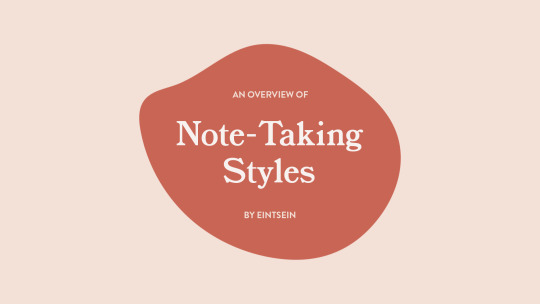

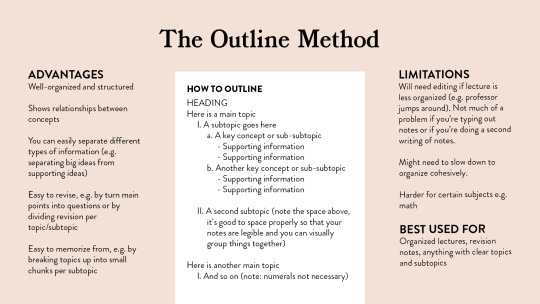


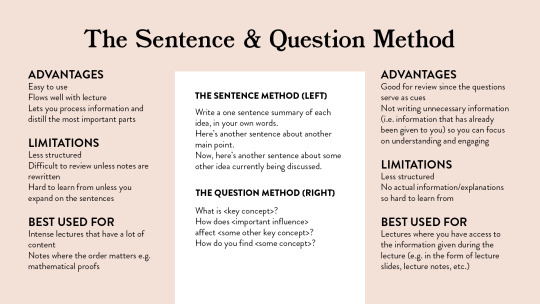



An Overview of Note-Taking Styles
Note-taking is one of the most essential skills a student should master. It allows you to record and review information to be used in the future. But what’s the best way to do so? Here’s an overview of note-taking styles that can help you maximize your learning!
#studyblr#studyspo#study hard#studying#notes#note-taking#mymp#mine#eintsein#productivity#motivation#inspiration#studyspiration#hey sareena#areistotle#studytildawn#studyblrmasterposts#graphic design#infographic
56K notes
·
View notes
Text
Hey! Even though this is my studyblr, I want to advertise my services. Right now, I’m doing $4 tarot readings, 1 question and 1 general reading. If you’re interested, just send me a message. I take CashApp or whatever works for you.
#creative#studyblr#tarot#bujo#witchcraft#witch#afro witch#study motivation#urban witch#hoodoo#witchblr#tarotreading#tarotcommunity#tarot deck#studying#study tips#study notes#money
10 notes
·
View notes
Text
Are you a woman of color who needs money for college or grad school?
Here are 100 scholarships to choose from:
Unless otherwise stated, all minority scholarships are applicable to women from underserved ethnic groups, including African Americans, Hispanics, Native Americans and Asians.
Arts Scholarships
Girls* Who Illustrate Awesomeness Scholarship
Apply here.
Blanche E. Coleman Foundation Scholarship
For more information contact the foundation using this information.
National Society of Arts and Letters Scholarships
Apply here.
Bev Sellers Scholarship
Learn more here.
BMI Foundation: John Lennon Scholarship
Apply here.
Worldstudio Foundation AIGA Scholarship
Apply here.
Women in Film Foundation Scholarship
Learn more here.
Education Scholarships
Nancy Larson Foundation College Scholarship
Apply here.
Minority Doctoral Loan For Service
Apply here.
National Academy of Education Spencer Dissertation Fellows
Apply here.
STEM Scholarships
Mickey Leland Energy Fellowship
Apply here.
Software Testing Scholarship
Apply here.
ASM Undergraduate Research Fellowship
Apply here.
Dr. Nancy Foster Scholarship
Apply here.
AWG Minority Scholarship
Apply here.
National Institutes of Health Undergraduate Scholarship Program
Apply here.
Stan Beck Fellowship
Apply here.
APS Minority Scholarship
Apply here.
AICPA Minority Accounting Students Scholarships
Apply here.
Mae & Mary Scholarship
Learn more here.
The Generation Google Scholarship
Apply here.
Microsoft Minority Scholarship
Learn more.
Charles Shelton Veterinary Medicine/Technology Scholarship
Apply here.
Brown and Caldwell Minority Scholarship
Apply here.
Surety & Fidelity Industry Intern and Scholarship Program
Apply here.
¡Adelante! Fund Scholarships
Apply here.
Elliott C. Roberts Scholarship
Apply here.
P.L.A.Y. Scholarship
Apply here.
Society of Hispanic Professional Engineers Scholarships
Apply here.
Gates Millennium Scholars Program
Apply here.
National Medical Fellowship Scholarships Program
Apply here.
SanDisk Scholars Fund
Apply here.
Hispanic Scholarship Fund
Apply here.
General Merit Scholarships
Udall Undergraduate Scholarships
Apply here.
Fulbright Scholars Program
Learn more here.
Courage to Grow Scholarship
Apply here.
BUICK Achievers Scholarships
Apply here.
Coca-Cola Scholars
Apply here.
Xerox Technical Minority Scholarship
Apply here.
Burger King Scholars
Apply here.
Roothbert Fund Scholarship
Apply here.
Liberty Mutual Scholarships
Apply here.
State Farm Good Neighbor Scholarship
Apply here.
LPGA Foundation Scholarship
Apply here.
NCAA Minority and Women’s Enhancement Graduate Scholarship
Apply here.
Discover Student Loans Scholarship
Apply here.
Scholarship America Dream Award
Apply here.
AXA Achievement Community Award
Apply here.
Catharine Lealtad Scholarships
More info here.
Marine Corps Scholarships
Apply here.
La Unidad Latina Foundation Scholarships
Apply here.
Jack Kent Cooke Foundation Scholarships
Learn more here.
GE – Reagan Foundation Scholarship
Learn more here.
Fundación Kinesis Scholarships
Learn more here.
Jackie Robinson Foundation Scholarship
Apply here.
National Association for the Advancement of Colored People
Apply here.
Ronald McDonald House Charities African American Future Achievers
Apply here.
The Paul & Daisy Soros Fellowships for New Americans
Apply here.
Omega Phi Beta – Reach for the Gold Scholarships
Apply here.
Questbridge Scholarship
Learn more here.
Ron Brown Scholar Program
Apply here.
United Negro College Fund
Learn more here.
DAR American Indian Scholarship
Learn more here.
Frances Crawford Marvin American Indian Scholarship
Learn more here.
Business Scholarships
American Bus Association Diversity Scholarship
Apply here.
FormSwift Scholarship
Apply here.
17oxen Digital Marketing Scholarship
Apply here.
Les Dames d’Escoffier International Scholarship
Apply here.
AICPA Minority Accounting Students Scholarships
Apply here.
Morgan Stanley Richard B. Fisher Scholarship Program
Apply here.
National Society of Hispanic MBAs Scholarship Program
Apply here.
Herman J. Neal Scholarship
Apply here.
HACU Scholarships
Apply here.
National Black MBA Association Scholarships
Apply here.
Surety & Fidelity Industry Intern and Scholarship Program
Apply here.
The Hyatt Hotels Fund for Minority Lodging Management Students
Apply here.
Minorities in Hospitality Scholars Program
Learn more here.
RICOH Scholarship Program
Learn more here.
Consortium for Graduate Study in Management
Learn more here.
Social Science Scholarships
ASA Minority Fellowship Program
Apply here.
Ronald E. McNair Scholars Program
Apply here.
Harry S. Truman Scholarship
Amount: $30,000 | Application Deadline: February
Apply here.
American Library Association Spectrum Scholarship
Apply here.
Fellowship on Women and Public Policy
Amount: $31,000 | Application Deadline: September
Apply here.
Jennings Randolph Peace Scholarship Dissertation Program
Amount: $20,000 | Application Deadline: November
Apply here.
Judith McManus Price Scholarship
Apply here.
Thomas R. Pickering Undergraduate & Graduate Foreign Affairs Fellowship
Amount: Up to $37,500 | Application Deadline: December
Apply here.
Martin Luther King, Jr. Scholarship Award
Learn more here.
Congressional Hispanic Caucus Institute Scholarship
Learn more here.
Law Scholarships
American Bar Association Jeanne P. Gray Diversity Scholarship
Learn more here.
Backfire & Backfire, P.C. Law School Diversity Scholarship
Apply here.
NALP Diversity Scholarships
Amount: Up to $30,000| Application Deadline: Varies
here.
Sidney B. Williams Scholarship
Apply here.
Communications Scholarships
The Jacqueline Woodson Fellowship for a Young People’s Writer of African or Caribbean Descent
Learn more here.
Proofreading.com Scholarship
Apply here.
The LAGRANT Foundation Scholarships
Apply here.
Leonard M. Perryman Communications Scholarship for Racial Ethnic Minority Students
Apply here.
National Press Club Scholarship for Journalism Diversity
Apply here.
Chips Quinn Scholars Program
Apply here.
Allison E. Fisher Scholarship
Apply here.
Emma Bowen Foundation Fellowship
Learn more here.
source
The list with more art scholarships – here: http://www.scholarshipsforwomen.net/art/
I’m so happy more opportunities are coming up! Scholarships are in effect a gift of free cash. Free cash is very popular in every society and nation. So the applicant and recipient of scholarship money has worked very hard and has much to offer our society and is a deserved winner. It is still a free cash gift… GET IT!
These presentations shows you how to write a winner scholarship:
application:http://www.thefreeschool.education/scholarships.html
#BlackGirls #EducatedBlack
125K notes
·
View notes
Text
How to Take Blocking Notes
Creating a Blocking Script
To create a blocking script generally one starts with a single-sided script. This leaves the other side of the two-page spread for an image / drawing of the stage and set. This is something you may have to create yourself, however, check in with the set designer first and see if that have something created you can use. Once you’ve done that, you can print that on the opposite side of your script so that the left side has the blocking image and the right is the script. That way when you open to the script page you can also see that page’s blocking.
It is also important to create a blocking key for all of the notation used in the script. This helps establish a convention and makes your blocking notes readable to someone if someone needs use it. It should be put in the front of the binder or tab of the binder.
Marking Acts and Scenes
When blocking scenes often the director will jump between scenes so it’s important to mark out the scenes and acts. This is most commonly done with post-it flags on the side of the script. These allow for the easy finding of the scene being worked on.
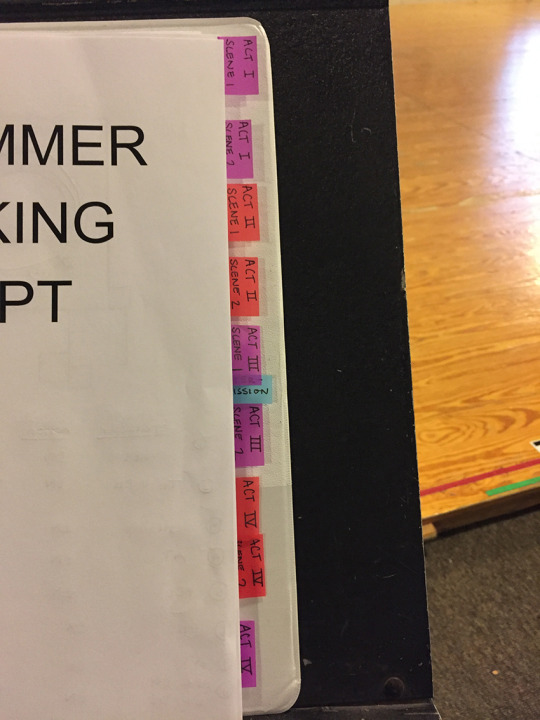
Common Notation
There are many ways of quick notation commonly used blocking terms that many stage managers and directors use. These should be put in your blocking key. Here is a blocking key that shows many of the commonly used notations. Also, it helps to create a shorthand for each character. Usually, you use the first two letters of the characters name. If there are two characters with the same two first letters you can use first three or the first two consonants that make it obvious who it is. This should also be put in the key.

Ways of Taking Blocking Notes
There are many ways to take blocking notes and they tend to vary slightly between people. Ultimately it is about finding a system that works for you and using only that. Here are three fairly common ways.
1. One way to take notes is to use lines and arrows on a map of the stage. In this method, you write down the character notation and draw a line from that to the location they land in marking the new location with an X. Then you label the path with a number that corresponded to a number in the script at the line the action occurs.
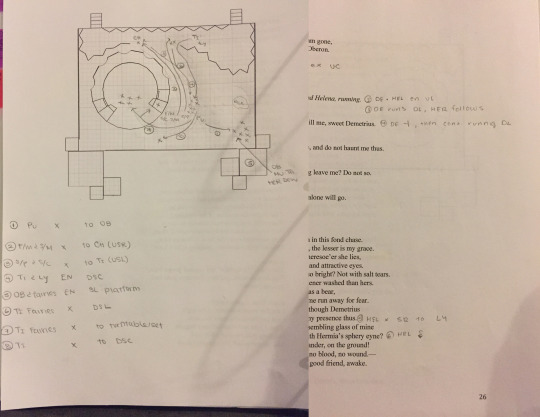
2. Another way is to use the numbers in the script, but then simply write out the action using blocking notation. This can be accompanied by small drawings if needed. This can be written in the script or on the opposite side.
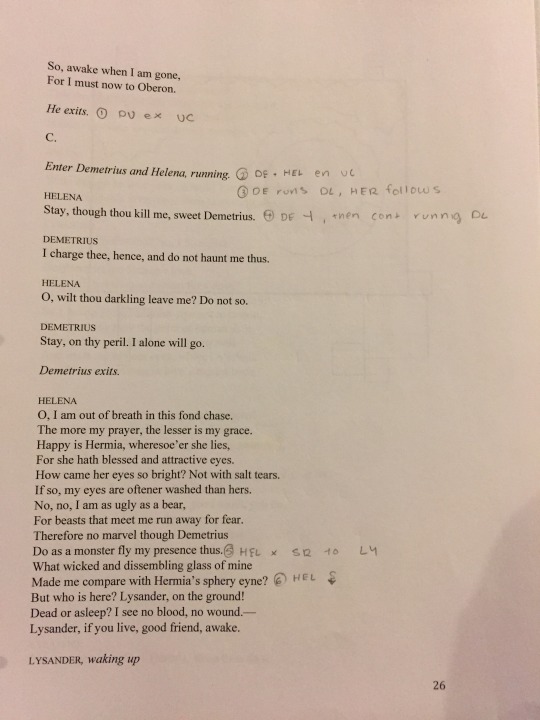
Other Helpful Tips
Always write blocking in pencil. Blocking by it its very nature is going to change many times. Because of this, it’s important to only write in pencil.
If you are the stage manager and someone else, and ASM or PA, is taking blocking for you make sure that you give them a key so that you can read the blocking. This just helps keep everything uniform and usable by all.
You can and should rewrite blocking after a rehearsal if it is messy due to time crunch or something else. Never assume that you will be able to understand your chicken scratch the next day because chances are the next day you will not.
580 notes
·
View notes
Text
Books for Sound Designers
A comprehensive list of useful sound design and audio engineering texts
Yamaha Sound Reinforcement Handbook
Master Handbook of Acoustics - Fifth Edition
Mixing a Musical - Shannon Slaton
Sound and Music for the Theatre - Deena Kaye, James LeBrecht
Show Networks and Control Systems - John Huntington
Sound Systems: Design and Operation - Bob McCarthy
Sound Reproduction - Loudspeakers and Rooms
Room Acoustics - Fifth Edition
Fundamentals of Acoustics - Fourth Edition
Audio Engineering: Know it All
Feel free to add more texts and/or provide links to PDF’s of the texts above if you have them! Lets help young designers and technicians like me get access to the education they want
989 notes
·
View notes
Text
elements of a compelling music recording
performance
timing (even tempo), intonation (in tune), tone, x-factor (putting the lyrics across in a way that really makes us listen and understand the composition of the story)
composition
melody, harmony (is the harmony supporting the melody), lyrics, form (different sections of a song, are they coming together in the right way, does it feel like you’re on a journey, is it worth it to listen to the song because of the climax)
production
vocal placement (vocals in comparison to other instruments, how close or far away are the vocals, far away (wet) close (dry)), intelligibility (can we hear all of the lyrics), tone (tone of the instruments themselves) focus (giving the listener enough cues to know where to put their focus or listen) effects (delays, etc. don’t be too distracting, add to the piece)
all in service of emotion. always be thinking how is this affecting the emotion of the listener.
116 notes
·
View notes
Text
Mixing at the Right Levels
There’s this theory of the ear that it hears different frequencies at different levels. The Fletcher-Munson curves, commonly known as equal-loudness contours, indicate the ear’s average sensitivity to different frequencies at various amplitude levels.

Even if the tonal balance of the sound remains the same, at low volume, mid range frequencies sound more prominent. While at high listening volumes, the lows and highs sound more prominent, and the mid range seems to back off.
In short, this explains why quieter music seems to sound less rich and full than louder music. Generally it’s better for the music to sound good as the volume increases.
As a consequence of this, you should edit, mix and work on your music on a high enough volume (not ridiculously loud), so that you can make sure your music doesn’t sound terrible when it’s listened to at a higher level. Because as a music producer you would want your music to sound best when the listener is paying full attention. But use caution, don’t damage your ears bla bla bla.
254 notes
·
View notes
Text
Today’s Best Tips on Music Production
10 essential tips… 20 mistakes… 30 production secrets and so on, such lists seem to be really popular these days. Although many of them are just full of crap. Especially forget about the longer checklists – even if you could find some good advices there, most tips are just nonsense, like “don’t mix bass with headphones”.
Anyway, to you aspiring producer, here’s a few things I think you should care about:
Limiting yourself can help drive creativity. Don’t use all of your instrumental arsenal at once, don’t try to cover all music styles in one track.
Listen to different styles of music and try to identify what you like and what you dislike.
Analyze your favorite artists’ work in great detail. Theorize with both feet on the ground.
Go ahead and copy other artists, but don’t settle there – tweak and add your own style and flavor.
Cover, remix and remake your favorite tracks, it’s a good and fun way to learn about music.
Use reference tracks, compare your shit to others, but don’t get paralyzed when your track doesn’t bang as loud as them.
Learn about synthesis and learn how to sound design different kind of instruments, e.g. strings, plucks, percussion (make synthetic drums using waveforms, a noise generator, filters, envelopes and such).
Check your music productions on several systems; from high-end studio monitor speakers to iPhone earbuds.
Sleep on it. Let your track mature over night and return to it with fresh ears.
Go hardware, get tactile if you are growing tired of a software-based environment. To actually play an instrument or to turn a real knob is really something else.
Get inspiration from collaborations with other artists. Just reach out to people you admire – this is globalization, this is the time of teh internetz.
Try to keep passionate about creating music, but don’t be afraid to make some demands of yourself, just to push things forward.
1K notes
·
View notes
Text
Bedroom Studio Tips Revisited
Three years ago I posted a list of some music production methods and tips on my blog that still gets some attention. Now, here’s some other good read (I hope).
About drum EQ
How to translate sub bass onto smaller speakers
Ideas on effect chain orders
How a compressor work
How to program synth strings
About mid/side processing
How to boost bass
How to create drum sounds with a synth
Moreover, you really should check out the most popular post on this blog about the best tips on music production that I can think of.
573 notes
·
View notes
Text
Straight Outta Bedroom

So I’ve had this blog for a year and a half now – yay! I’ve primarily focused on music production methods and tips. If you’re into that, making music, then here are a few (not all) old posts that could interest you. Now, did you ever wonder…
How the hell to program a killer bass?
How to master shit in your bedroom studio?
What to do just to sound tight?
How to record and mix vocals at home?
How to work the 808 kick with a sub?
How to route side-chain compression?
Which fucking BPM to use for your track?
How to bring clarity to your mix?
How to structure your song, where to put the drop?
About the old Haas effect?
How to work with parallel processing?
You’re welcome.
426 notes
·
View notes
Text
How To Develop A Distinct Voice In Your Writing
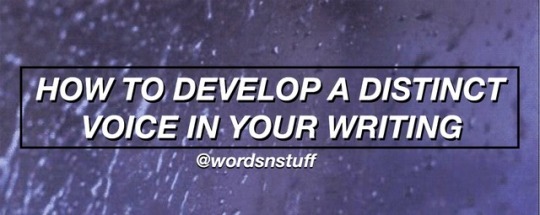
Voice in writing is extremely important and can make or break your story as a whole. It’s imperative that you pay attention to how readers interpret your writing voice because loving the author’s storytelling style can sometimes be just as important as the story itself. Here are some tips to remember and some general rules to follow in order to make sure your writing voice is enjoyable to listen to for your audience.
General Introduction & Some Things To Note
Voice is an audience’s ability to read something and know you wrote it. It’s essentially your fingerprint on your work.
The syntax is how an author chooses to order words in a sentence and can play a large role in conveying your voice.
Voice does not have to be yours alone, but more on that later.
How To Develop Your Voice
Rule 1: Write Naturally
Use voice as a tool, but don’t let it control you. Don’t try to force voice into your writing. Forcing voice can make it sound awkward and push the reader away.
Rule 2: Always Write For Clarity First
Be as clear as possible. Don’t embellish or use fancy words if unnecessary. If writing poetry, however, do the exact opposite.
Rule 3: Don’t Deviate Too Much From The Rules Of Writing
Doing this can alienate your readers. If you break the everyday rules too much and deviate from the technical conventions of writing, your readers may get distracted or lose track of what you’re trying to convey and what’s going on in the story as a whole.
Writing In Somebody Else’s Voice
A lot of authors choose to write stories from the point of view of a character in their story. Authors may also choose to write in a format that requires their voice to be that of someone who may be completely different than them. Being able to recognize small details that form a voice in your readers’ heads is very important, whether you’re telling them the story as yourself or through the eyes of another. Here are some tips on developing a voice that matches the point of view you are telling the story from:
Word Choice ~ Use words and phrases that are true to the character’s personality. If your character is a 21st-century teenager talking about some guy they’re “totally obsessed” with and want to “Netflix and Chill” with, then they probably won’t describe him as a “harrowing barbarian with golden flowing locks and a stone cold thirst for vengeance”.
Observation ~ Be careful when describing what your narrator observes throughout the story. If your narrator is supposed to be somewhat oblivious or gullible, they won’t notice the incredibly subtle mannerisms in everyone around them in order to conveniently draw conclusions and convey every piece of information the reader needs to predict the ending of the story.
Focus ~ Be mindful of what your narrator focuses on when describing a situation or the people around them. If your narrator chooses to point out that a character they don’t like happens to have the latest Rolex, this will hint at the reader that the character has a distaste for those with lots of wealth and therefore is somewhat of the opposite of the person they dislike. The things a person focuses on can tell you a lot about who they are and what they think of the world, and that is a massive deal when it comes to voice.
Descriptions ~ How your character describes the situations and minute details is important. Whether they say “shuddered” instead of “shook” or “steamed” instead of “angry” plays a large part in the reader getting to know your narrator.
Request a prompt list/writing advice/playlist/study help post here
4K notes
·
View notes
Text
Tips to learn a new language
The 75 most common words make up 40% of occurrences
The 200 most common words make up 50% of occurrences
The 524 most common words make up 60% of occurrences
The 1257 most common words make up 70% of occurrences
The 2925 most common words make up 80% of occurrences
The 7444 most common words make up 90% of occurrences
The 13374 most common words make up 95% of occurrences
The 25508 most common words make up 99% of occurrences
(Sources: 5 Steps to Speak a New Language by Hung Quang Pham)
This article has an excellent summary on how to rapidly learn a new language within 90 days.
We can begin with studying the first 600 words. Of course chucking is an effective way to memorize words readily. Here’s a list to translate into the language you desire to learn that I grabbed from here! :)
EXPRESSIONS OF POLITENESS (about 50 expressions)
‘Yes’ and ‘no’: yes, no, absolutely, no way, exactly.
Question words: when? where? how? how much? how many? why? what? who? which? whose?
Apologizing: excuse me, sorry to interrupt, well now, I’m afraid so, I’m afraid not.
Meeting and parting: good morning, good afternoon, good evening, hello, goodbye, cheers, see you later, pleased to meet you, nice to have met.
Interjections: please, thank you, don’t mention it, sorry, it’ll be done, I agree, congratulations, thank heavens, nonsense.
NOUNS (about 120 words)
Time: morning, afternoon, evening, night; Sunday, Monday, Tuesday, Wednesday, Thursday, Friday, Saturday; spring, summer, autumn, winter; time, occasion, minute, half-hour, hour, day, week, month, year.
People: family, relative, mother, father, son, daughter, sister, brother, husband, wife; colleague, friend, boyfriend, girlfriend; people, person, human being, man, woman, lady, gentleman, boy, girl, child.
Objects: address, bag, book, car, clothes, key, letter (=to post), light (=lamp), money, name, newspaper, pen, pencil, picture, suitcase, thing, ticket.
Places: place, world, country, town, street, road, school, shop, house, apartment, room, ground; Britain, name of the foreign country, British town-names, foreign town-names.
Abstract: accident, beginning, change, color, damage, fun, half, help, joke, journey, language, English, name of the foreign language, letter (of alphabet), life, love, mistake, news, page, pain, part, question, reason, sort, surprise, way (=method), weather, work.
Other: hand, foot, head, eye, mouth, voice; the left, the right; the top, the bottom, the side; air, water, sun, bread, food, paper, noise.
PREPOSITIONS (about 40 words)
General: of, to, at, for, from, in, on.
Logical: about, according-to, except, like, against, with, without, by, despite, instead of.
Space: into, out of, outside, towards, away from, behind, in front of, beside, next to, between, above, on top of, below, under, underneath, near to, a long way from, through.
Time: after, ago, before, during, since, until.
DETERMINERS (about 80 words)
Articles and numbers: a, the; nos. 0–20; nos. 30–100; nos. 200–1000; last, next, 1st–12th.
Demonstrative: this, that.
Possessive: my, your, his, her, its, our, their.
Quantifiers: all, some, no, any, many, much, more, less, a few, several, whole, a little, a lot of.
Comparators: both, neither, each, every, other, another, same, different, such.
ADJECTIVES (about 80 words)
Color: black, blue, green, red, white, yellow.
Evaluative: bad, good, terrible; important, urgent, necessary; possible, impossible; right, wrong, true.
General: big, little, small, heavy; high, low; hot, cold, warm; easy, difficult; cheap, expensive; clean, dirty; beautiful, funny (=comical), funny (=odd), usual, common (=shared), nice, pretty, wonderful; boring, interesting, dangerous, safe; short, tall, long; new, old; calm, clear, dry; fast, slow; finished, free, full, light (=not dark), open, quiet, ready, strong.
Personal: afraid, alone, angry, certain, cheerful, dead, famous, glad, happy, ill, kind, married, pleased, sorry, stupid, surprised, tired, well, worried, young.
VERBS (about 100 words)
arrive, ask, be, be able to, become, begin, believe, borrow, bring, buy, can, change, check, collect, come, continue, cry, do, drop, eat, fall, feel, find, finish, forget, give, going to, have, have to, hear, help, hold, hope, hurt (oneself), hurt (someone else), keep, know, laugh, learn, leave, lend, let (=allow), lie down, like, listen, live (=be alive), live (=reside), look (at), look for, lose, love, make, may (=permission), may (=possibility), mean, meet, must, need, obtain, open, ought to, pay, play, put, read, remember, say, see, sell, send, should, show, shut, sing, sleep, speak, stand, stay, stop, suggest, take, talk, teach, think, travel, try, understand, use, used to, wait for, walk, want, watch, will, work (=operate), work (=toil), worry, would, write.
PRONOUNS (about 40 words)
Personal: I, you, he, she, it, we, they, one; myself, yourself, himself, herself, itself, ourselves, yourselves, themselves.
Possessive: mine, yours, his, hers, its, ours, theirs.
Demonstrative: this, that.
Universal: everyone, everybody, everything, each, both, all, one, another.
Indefinite: someone, somebody, something, some, a few, a little, more, less; anyone, anybody, anything, any, either, much, many.
Negative: no-one, nobody, nothing, none, neither.
ADVERBS (about 60 words)
Place: here, there, above, over, below, in front, behind, nearby, a long way away, inside, outside, to the right, to the left, somewhere, anywhere, everywhere, nowhere, home, upstairs, downstairs.
Time: now, soon, immediately, quickly, finally, again, once, for a long time, today, generally, sometimes, always, often, before, after, early, late, never, not yet, still, already, then (=at that time), then (=next), yesterday, tomorrow, tonight.
Quantifiers: a little, about (=approximately), almost, at least, completely, very, enough, exactly, just, not, too much, more, less.
Manner: also, especially, gradually, of course, only, otherwise, perhaps, probably, quite, so, then (=therefore), too (=also), unfortunately, very much, well.
CONJUNCTIONS (about 30 words)
Coordinating: and, but, or; as, than, like.
Time & Place: when, while, before, after, since (=time), until; where.
Manner & Logic: how, why, because, since (=because), although, if; what, who, whom, whose, which, that.
240K notes
·
View notes
Text
french: school vocabulary 📚
♡ Basics:
une école - school (in general), grade school
un écolier, une écolière - grade school student
un collège - middle school, junior high
un collégien, une collégienne - middle school student
un lycée - high school
un lycéen, une lycéenne - high school student
une université - college, university
un étudiant, une étudiante - college student
un professeur, un/e prof (informal)* - teacher
*In France, the word professeur is always masculine, even if the teacher is a woman.
♡ School Years and Ages:
Cours Préparatoire (CP) = 6 years old
Cours Elémentaire (CE1) = 7 years old
Cours Elémentaire (CE1) = 8 years old
Cours Moyen (CM1) = 9 years old
Cours Moyen (CM2) = 10 years old
Sixième = 11 years old
Cinquième = 12 years old
Quatrième = 13 years old
Troisième = 14 years old
Seconde = 15 years old
Première = 16 years old
Terminale = 17 years old
♡ Equipment - Le Matériel
un bureau - desk
un pupitre - student desk
un cahier - notebook
une calculatrice - calculator
un carnet - notebook
une carte - map
un classeur - binder
une craie - chalk
un crayon - pencil
des devoirs (m) - homework
un dictionnaire - dictionary
une gomme - eraser
le rétroprojecteur - overhead projector
un livre - book
la trousse - pencil case
le papier - paper
une feuille de papier - piece of paper
recto verso - front and back, both sides
un sac à dos - backpack
un stylo - pen
un tableau - chalkboard
le cartable - school bag
♡ The School:
classroom - une salle de classe
library - la bibliothèque
librarian - le/la documentaliste
hall - le hall
staff room - une salle des profs
cloakroom - le vestiaire
toilets - les toilettes
laboratory - un laboratoire
workshop - un atelier
gym - le gymnase
the playground - la cour de récréation
sports field - le terrain de sports
headmaster - le directeur
headmistress - la directrice
secretary - la secrétaire
dining hall - la cantine
corridor - le couloir
caretaker - le concierge
school yard - la cour
♡ Subjects - Les Matières
English - l'anglais
Mathematics - les mathématiques
Modern Languages - les langues vivantes
French - le français
Spanish - l'espagnol
German - l'allemand
Greek - le grec
Latin - le latin
Physical Science - les sciences physiques
Physics - la physique
Chemistry - la chimie
Biologie - la biologie
Technology - le travail manuel éducatif (TME)
Woodwork - le travail sur bois
Art - le dessin
Computing (IT) - l'informatique
Music - la musique
Geography - la géographie
History - l'histoire
Physical Education (PE) - l'éducation physique et sportive (EPS)
Religious Education (RE) - l'instruction religieuse
♡ School Life
lesson - un cours
pupil - une élève
to spell - épeler
to learn - apprendre
to discuss - discuter
essay - la rédaction
school uniform - l’uniforme
bell - le sonnerie
homework - les devoirs
timetable - un emploi de temps
to take notes - prendre des notes
term/semester - un trimestre
detention - le retenue
study period - l'étude
un examen - test
♡ Classroom activities and instructions
lever la main - to put one’s hand up
poser une question - to ask a question
écrivez - write down
écoutez - listen to
regardez - look at
regardez attentivement - look closely
lisez - read
lisez attentivement - read carefully
…le texte - the text
…l'enregistrement - the recording
…la conversation - the conversation
…la vidéo - the video
…l'écran - the screen
ouvrez - open
…votre cahier - your workbooks
…votre livre - your (text) books
…le manuel - the textbook
cochez la bonne réponse - tick the right answer
je vais vous donner un devoir - I’m going to give you some homework
c'est pour - it’s for
il faut le rendre - you’ve to hand it in
…demain - tomorrow
…la semaine prochaine - next week
…après les vacances - after the holidays
allez, c'est parti! - come on, let’s start!
faites moins de bruit, s'il vous plaît! - quieten down, please!
taisez-vous! - be quiet!
3K notes
·
View notes
Text
Basic conversation
Small talk :
- hello : bonjour / bonsoir (after 6pm), salut (familiar)
- goodbye : au revoir, salut (familiar)
- good afternoon : bonne après-midi (when you leave)
- goodnight : bonne soirée (when you leave)
- how are you : comment ça va ? ça va ? (familiar)
- I’m fine : je vais bien, ça va
- thank you (very much) : merci (beaucoup)
- you’re welcome : de rien
- see you later / tonight / tomorrow : on se voit plus tard / ce soir / demain
La présentation :
- what is your name ? : comment tu t’appelles / comment vous appelez-vous ? ; quel est ton / votre nom ?
- my name is _ : je m’appelle _ (literally “I call myself _”)
- how old are you ? quel âge as-tu / avez-vous ?
- I’m _ years old : j’ai _ ans (”I have _ years”)
- and a half : et demi
- how tall are you ? : quelle taille mesures-tu / mesurez-vous ?
- I am 5′7/1,70m : je mesure / fais un mètre soixante-dix
- are you single ? : es-tu / êtes-vous célibataire ? as-tu / avez-vous quelqu’un dans votre vie ? (”do you have anyone in your life ?”)
- I am dating someone : je suis en couple / avec quelqu’un) ; je vois quelqu’un (”I’m seeing someone”) sounds less serious, also used to mention a therapist)

Les questions :
- what about you ? : et toi / vous ?
- what’s new ? : qu’est-ce qu’il y a de nouveau ? ; quoi de neuf ? (familiar)
- what do you mean ? : comment ça ? ; qu’est-ce que tu veux / vous voulez dire ? c’est-à-dire ?
- what is that ? : qu’est-ce que c’est (que ça / cela) ?
- who is that ? qui est-ce ? qui c’est ? (familiar)
- I don’t remember : je ne me rappelle pas
- I don’t remember that : je ne m’en rappelle pas
- sorry ? : pardon ? excuse-moi / excusez-moi ?
- are you sure ? : es-tu / êtes-vous sûr.e ?
- are you sure about that ? : en es-tu / en êtes-vous sûr.e ? c’est sûr ? (familiar)
- I don’t know : je ne sais pas
- I don’t really know : je ne sais pas trop / pas vraiment
- who knows ? : qui sait ?
Les gros mots :
- shit : merde / fait chier
- fuck : putain (usable in pretty much any situation)
- shut up : (ferme / fermez) ta / votre (sg) / vos (pl) gueule.s
- asshole : trou du cul / trou de balle
- fucker : connard / connasse
- bastard : bâtard
- bitch : sale pute
- / : nom de Dieu (”in the name of god”, when you’re pissed)
- I don’t give a fuck : je m’en fous ; je m’en branle (branler : to masturbate) ; je m’en cogne ; je n’en ai rien à foutre ; je n’en ai rien à carrer ; je m’en bats les couilles (for males) or je m’en bats les ovaires (females)
- go fuck yourself : va te / allez vous faire foutre ; va / allez chier
- go die : va / allez mourir ; va / allez crever (familiar)
- son of a bitch : fils de pute

883 notes
·
View notes
Text
Les verbes à connaître
If you’re a beginner, you might want to learn some very used verbs. Those are found very frequently, mostly in literal ways.
- to be : être
- to have : avoir
- to do : faire
- to make : faire
- to eat : manger
- to drink : boire
- to sleep : dormir
- to play : jouer
- to work : travailler
- to go : aller
- to go in : entrer
- to go out : sortir
- to go back : rentrer
- to arrive : arriver
- to live : vivre
- to die : mourir

- to sing : chanter
- to dance : danser
- to walk : marcher
- to run : courir
- to swim : nager
- to go up the stairs : monter (les escaliers)
- to go down the stairs : descendre (les escaliers)
- to fall : tomber
- to jump : sauter
- to have a fight : se battre
- to carry : porter
- to drive : conduire
- to bring : emmener (a person), emporter (a thing)
- to drop : faire tomber
- to get up : se lever
- to wake up : se réveiller
- to go to bed : aller se coucher
- to sit down : s’asseoir
- to see : voir
- to look : regarder
- to speak : parler
- to talk : parler, discuter
- to hear : entendre
- to listen : écouter
- to touch : toucher
- to feel : sentir
- to smell : sentir

- to laugh : rire
- to cry : pleurer
- to mean : signifier, vouloir dire
- to scream : crier
- to whisper : chuchoter
- to smile : sourire
- to mutter : murmurer
- to read : lire
- to watch : regarder
- to think : penser
- to imagine : imaginer
- to win : gagner
- to lose : perdre
- to argue : débattre
2K notes
·
View notes
Text
les couleurs
basic colours💐
bleu (-e) - blue
vert (-e) - green
jaune - yellow
rouge - red
rose - pink
violet (-te) - purple
marron - brown
noir (-e) - black
blanch (-e) - white
orange - orange
gris (-e) - grey
argent - silver
or - gold
clair - light [eg. light blue - bleu clair]
foncé - dark [eg. dark pink - rose foncé]
la prononciation (not for all of them, unfortunately)
hair colours🌹
les cheveux noirs - black hair
les cheveux blonds (-es) - blonde hair
les cheveux bruns - brown hair
les cheveux roux - red hair
the (-e) and (-te) are the feminine version of the colours, eg. la pomme est verte
60 notes
·
View notes
Text
Conjugation Rules in French
1. Verb groups
There are three groups of verbs in French. The first one ends with –er, the second with –ir, and the third with –re, -oir, and –ir. These groups basically determine how the verbs are conjugated. For the most part, you can tell with group the verb belongs to just by looking at the ending, but in the case of –ir verbs, it’s a little trickier. The difference between second-group –ir and third-group –ir is the ending of the participe présent (present participle, a.k.a verbs ending in –ing): second-group verbs end in –issant, while third-group verbs end in –ant.
The third group is the one with all the irregular verbs, so it’s better to check the conjugation just to be sure.
2. Verb radicals
First group
For the present and imperfect tenses, the radical is the verb without the ending.
e.g.: aim- for aimer, parl- for parler
For the future and conditional tenses, the radical is the same as the verb.
e.g.: aimer- for aimer, parler- for parler
Second group
For the present tense, the radical is the verb with the r.
e.g.: fini- for finir, guéri- for guérir
For the imperfect tense, the radical is the same as the present tense, but you also add ss to it.
e.g.: finiss- for finir, guériss- for guérir
For the future and conditional tenses, the radical is the same as the verb.
e.g.: finir- for finir, guérir- for guérir
Third group (there are exceptions everywhere)
-re
For the present and imperfect tenses, the radical is the verb without the ending.
e.g.: vend- for vendre, prend- for prendre
For the future and conditional tenses, the radical is the verb with the r.
e.g.: vendr- for vendre, prendr- for prendre
-ir
For the present and imperfect tenses, the radical is the verb without the ending.
e.g.: ouvr- for ouvrir, ment- for mentir
For the future and conditional tenses, the radical is the same as the verb.
e.g.: ouvrir- for ouvrir, mentir- for mentir
HOWEVER there are exceptions for the –ir verbs
For the present and imperfect tenses, the radical is the verb without the three last letters.
e.g.: sor- for sortir, dor- for dormir
-oir
These are all irregular and you should look them up.
e.g.: savoir, pouvoir, recevoir
Present: sa- (je/tu/il)/ sav- (nous/vous/ils) for savoir, peu- (je/tu/il)/ pouv- (nous/vous/ils) for pouvoir, rec/reç (je/tu/il)/ recev- (nous/vous/ils) for recevoir
Imperfect: sav- for savoir, pouv- for pouvoir, recev- for recevoir
Future and Conditional: saur- for savoir, pourr- for pouvoir, recevr- for recevoir
3. Verb endings
First group:

Second group:

Third group:
-re

-oir (all irregular, please look these up)
e.g.: savoir

e.g.: pouvoir

e.g.: recevoir

-ir
e.g.: ouvrir

e.g.: dormir

*Since these are irregular verbs, it is possible that not all are conjugated according to these tables*
1K notes
·
View notes